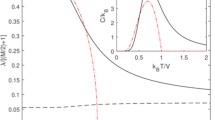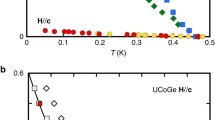Abstract
A theoretical methodology for exploring the conventional Bardeen–Cooper–Schrieffer (BCS) pairing instability for superconductivity from a correlated normal phase for all possible degrees of many-body correlation has been developed. The Gutzwiller projection scheme with a correlation parameter was made use of in generating the BCS pairing state. A variational scheme was thereafter implemented, leading to a self-consistent equation for superconducting gap function. This equation shows explicit dependence of the gap function on the many body correlation parameter. This ‘pairing-gap’ and the corresponding self-consistent gap equation in zero correlation limit, becomes identical in nature with those of the pure (1-well) BCS formalism, as expected and the Coulomb correlation affects the pairing significantly with the strength of correlation. The detailed consequences are being presented here.
Graphic Abstract






Similar content being viewed by others
Data Availability Statement
This manuscript has no associated data or the data will not be deposited. [Authors’ comment: Based on our analytical results, we added all the data to this manuscript and there are no more data to deposit.]
References
D. K. Thapa, S. Islam, S. K. Saha, P. S. Mahapatra, B. Bhattacharyya, T. P. Sai, R. Mahadevu, S. Patil, A. Ghosh, A. Pandey, arXiv:1807.08572, (2019)
D.J. Scalapino, R.D. Parks, Superconductivity (Marcel Dekker, New York, 1969), p. 449
P.B. Allen, B. Mitrovic, Solid State Physies, edited by H. Ehrenreich, F. Seitz, D., vol. 37 (Turnbull Academic, New York, 1982), p. 1
V.L. Ginzburg, D.A. Kirzhnits, High-Temperature Superconductivity, Chapter-I (Consultants Bureau, New York, 1982)
N.W. Ashcroft, Phys. Rev. Lett. 21, 1748–1750 (1968)
N.W. Ashcroft, Phys. Rev. Lett. 92, 187002 (2004)
A.P. Drozdrov, M.I. Eremets, I.A. Troyan, V. Ksenofontov, S.I. Shylin, Nature 525, 73–76 (2015)
M. Somayazulu, M. Ahart, A. Mishra, Z.M. Geballe, M. Baldini, Y. Meng, V.V. Struzhkin, R.J. Memley, Phys. Rev. Lett. 122, 027001 (2019)
E. Snider, N. Dasenbrock-Gammon, R. McBride, M. Debessai, H. Vindana, K. Vencatasamy, K.V. Lawler, A. Salamat, R.P. Dias, Nature 588(7837), E18 (2020)
D. Rybicki, M. Jurkutat, S. Reichardt, C. Kapusta, J. Haase, Nat. Commun. 7, 11413 (2016)
D. Chakraborty, C. Morice, C. Pépin, Phys. Rev. B 97, 214501 (2018)
J. Bardeen, L.N. Cooper, J.R. Schrieffer, Phys. Rev. 108, 1175 (1957)
M. Tinkham, Introduction to Superconductivity (Dover Publications, Mineola, 1996)
T.C. Paulick, C.E. Campbell, Phys. Rev. B 16, 2000 (1977)
Z. Wang, J.R. Engelbrecht, S. Wang, H. Ding, S.H. Pan, Phys. Rev. B 65, 064509 (2002)
E. Krotscheck, R.A. Smith, A.D. Jackson, Phys. Lett. B 104, 421 (1981)
M.C. Gutzwiller, Phys. Rev. Lett. 10, 159 (1963)
M. Causula, S. Sorella, J. Chem. Phys. 119, 6500 (2003)
J.R. Schrieffer, Theory of Superconductivity (CRR Press, New York, 2018), pp. 36–39
S. Sorella, Phys. Rev. B 64, 024512 (2001)
E. Krotschek, J. Low. Temp. Phys. 119, 103 (2000)
K. Mandal, Study of electron-electron correlation in Cooper pair problem in a low dimensional system and modified gap equation Post M.Sc. project at S N Bose Centre (done under the supervision of R. Chaudhury) (2017)
K. Chatterejee, Two-well model with Cooper pairing mechanism and isotope exponent from BCS theory M.Sc. project at S N Bose Centre (done under the supervision of R. Chaudhury) (2018)
S. Bhattacharjee, R. Chaudhury, Phys. B 500, 133 (2016)
S. Bhattacharjee, R. Chaudhury, J. Low. Temp. Phys. 193, 21 (2018)
M. Saarela, E. Krotscheck, J. Low. Temp. Phys. 90, 415 (1993)
H.H. Fan, E. Krotscheck, T. Lichtenegger, D. Mateo, R.E. Zillich, Phys. Rev. A 92, 023640 (2015)
R.B. Wiringa, S.C. Pieper, Phys. Rev. Lett. 89, 182501 (2002)
G.R. Stewart, Rev. Sci. Instrum. 54(1), 1–11 (1983)
T.C. Chi, J. Phys. Chem. Ref. Data 8(2), 339–438 (1979)
R.A. Matula, J. Phys. Chem. Ref. Data 8(4), 1147–1298 (1979)
J.P. Carbotte, Rev. Mod. Phys. 62, 1027 (1990)
S. C. Ganguly, V. Vano, S. Kezilebieke, J. L. Lado, P. Liljeroth, arxiv: 2009.12422v1 [con-matt.mess-hall] (2020)
Acknowledgements
KM and RC would like to thank the Department of Condensed Matter Physics and Material Sciences, S. N. Bose National Centre for Basic Sciences, for their kind hospitality. KM thanks UGC for the financial support [ref. no. 522495(2016)].
Author information
Authors and Affiliations
Contributions
KM and RC defined this problem. KM did calculations. KM and RC wrote the manuscript together.
Corresponding author
Appendices
Appendix A
Normalization of the Coulomb correlated state:
Here, the orthogonality of the states set a condition, for which only the terms with equal number of fermion Creation and annihilation operators will contribute with a non-zero value to that normalization. Therefore,
Appendix B
Total energy expectation W:
Kinetic energy operator expectation value:
This calculation is done by classifying the contribution coming out from the states which are specified with the power of \(\alpha \), and they are listed as below:
The contribution of potential energy expectation value is deduced in a similar manner and these are added in this section.
Rights and permissions
About this article
Cite this article
Mandal, K., Chaudhury, R. Interplay of pairing correlation and Coulomb correlation in Boson exchange superconductors. Eur. Phys. J. B 94, 46 (2021). https://doi.org/10.1140/epjb/s10051-021-00051-9
Received:
Accepted:
Published:
DOI: https://doi.org/10.1140/epjb/s10051-021-00051-9




